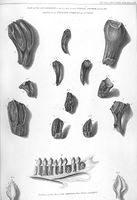Stone Age Europeans could survive extreme cold, wild animals and disease -- but not milk.From Tom Spears in the Ottawa Citizen:
Tests on skeletons from Europeans who lived around 5000 BC show they all shared the genetic trait we call "lactose intolerance," which meant that adults who drank milk would suffer bloating and diarrhea.
But suddenly, that all changed. With the arrival of dairy herds, the gene that lets some adults digest milk became the single greatest key to survival all across Europe, a new study says.
Today, more than 90 per cent of northern Europeans can digest milk as adults. That's a complete rewriting of the genetic blueprint carried by Neolithic peoples of 5000 BC.
The gene that produces lactase was probably a minor little mutation that popped up occasionally in small numbers all along, says genetics expert Earl Brown of the University of Ottawa.
"It would be like the one extra blade on your Swiss Army knife that you never use. It's just hanging on your belt," he said. "Then suddenly you need it. And anyone who has that blade has a big evolutionary advantage."
You’re right in noticing a slow down in postings. Acute tendonitis is limiting my time at the keyboard and that has to be spent on ‘real' work. Things will normalize when they do….















































